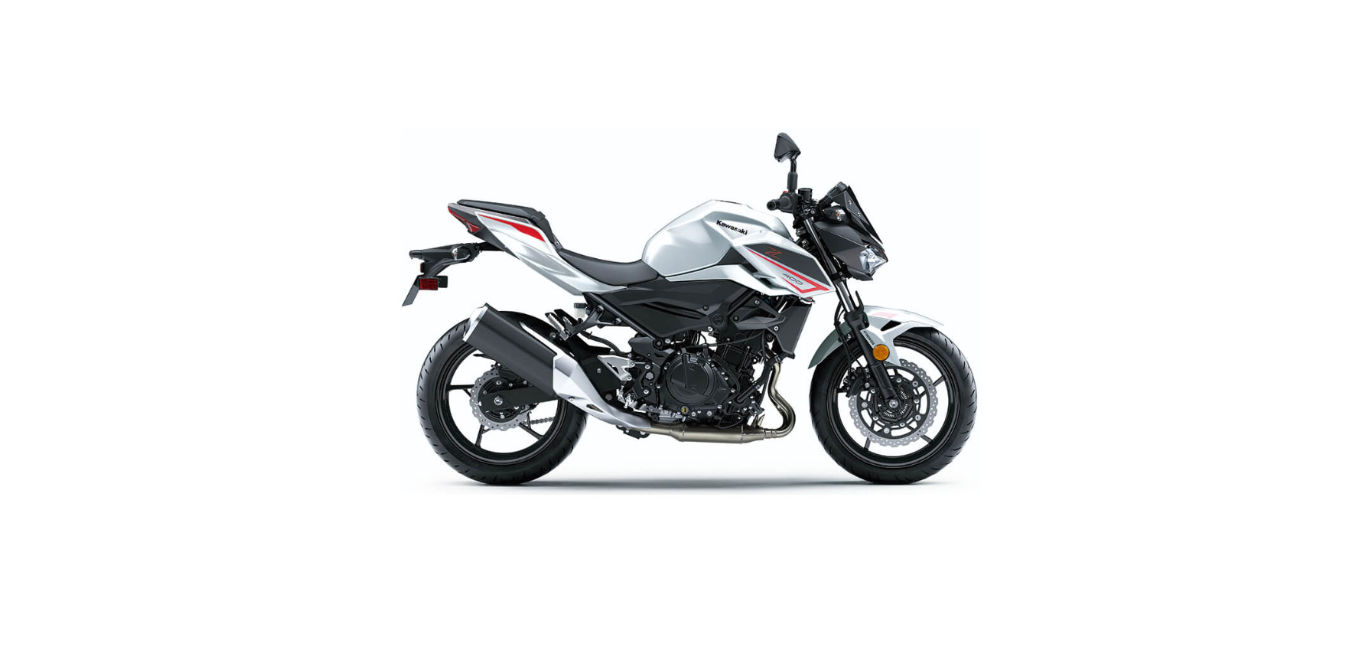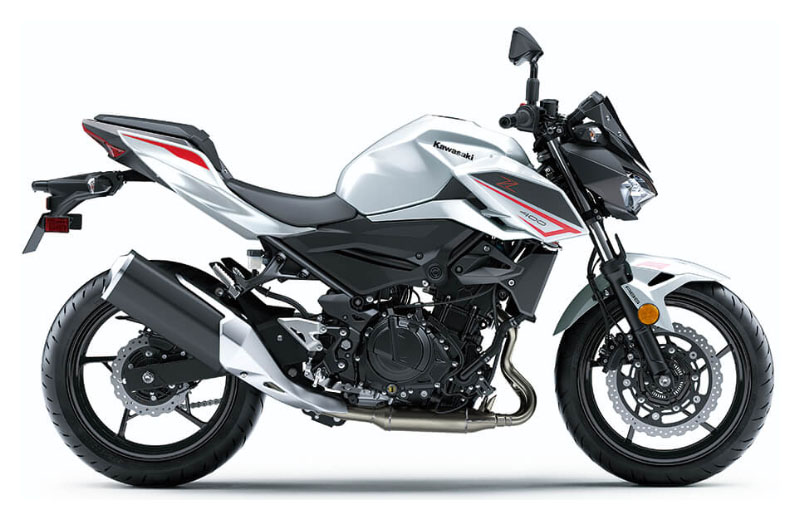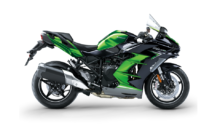2022 Kawasaki Z400 ABS Safe Operation Owners Manual




2022 Kawasaki Z400 ABS Safe Operation


Safe Operation
The following should be carefully observed for safe and effective vehicle operation.
Carbon Monoxide Hazard
DANGER
Exhaust gas contains carbon monoxide, a colorless, odorless poisonous gas. Inhaling carbon monoxide can cause serious brain injury or death. DO NOT run the engine in enclosed areas. Operate only in a well-ventilated area.
Fueling
WARNING
Gasoline is extremely flammable and can be explosive under certain conditions. To avoid possible fire or explosion, turn the ignition switch off. Do not smoke. Make sure the area is well-ventilated and free from any source of flame or sparks; this includes any appliance with a pilot light.
Never Ride with Drugs or Alcohol
Alcohol and drugs impair your judgment and reaction time. Never consume alcohol or drugs before or while riding motorcycles.
Protective Gear and Clothing
Helmet
Kawasaki strongly recommends both the operator and passenger wear a DOT-approved helmet even if this is not a legal requirement.
- Make sure that your helmet fits correctly and is properly fastened.
- Choose a motorcycle helmet that meets DOT safety standards. Ask your motorcycle dealer to advise you if necessary.
Eye Protection
Always use eye protection. If your helmet does not have a visor installed, wear goggles.
Gloves
Wear gloves that have suitable protection for your hands, especially against abrasion.
Clothing
Wear riding wear which have protectors for each parts of the body (chest, shoulders, back, elbows and knees, etc.) as much as possible, or wear protectors for them.
- Always wear a long-sleeved jacket and long trousers which are abrasion resistant and keep you warm.
- Wear clothing that allows freedom of movement.
- Avoid wearing clothes that have loose cuffs or other fastenings which could interfere with the controls of your motorcycle.
- Wear bright, highly visible clothing.
Boots
Wear proper protective boots that fit properly and do not interfere with gear shifting or braking.
Safe Riding Techniques
Keep Hands on Handlebars
When riding always keep both hands on the handlebars and both feet on the footpegs. Removing your hands from the handlebars or feet from the footpegs while riding can be hazardous. If you remove even one hand or foot, you reduce your ability to control the motorcycle.
Look Over Your Shoulder
Before changing lanes, look over your shoulder to make sure the way is clear. Do not rely solely on the rearview mirror; you may misjudge a vehiCle’s distance and speed, or you may not see it at all.
Accelerate and Brake Smoothly
In general, your actions should be smooth as sudden acceleration, braking or turning may cause loss of control, especially when riding in wet conditions or on loose road surfaces when the ability to maneuver will be reduced.
Select Correct Gear Speeds
When going up steep slopes, shift to a lower gear so that there is the power to spare rather than overloading the engine.
Use Both Front and Rear Brakes
When applying the brakes, use both the front and rear brakes. Applying only one brake for sudden braking may cause the motorcycle to skid and lose control.
Use Engine Brake
When going down long slopes, help control vehicle speed by closing the throttle so that the engine can act as an auxiliary brake. Use the front and rear brakes for primary braking.
Riding in Wet Conditions
Rely more on the throttle to control vehicle speed and less on the front and rear brakes. The throttle should also be used judiciously to avoid skidding the rear wheel from too rapid acceleration or deceleration. Braking performance is also reduced in wet conditions. Carefully ride at a slow speed and apply the brakes several times to help dry and restores them to normal operating performance. Lubricate the drive chain after wet weather riding to prevent rust and corrosion.
Ride Prudently
Riding at the proper speed and avoiding unnecessarily fast acceleration are important not only for safety and low fuel consumption but also for long vehicle life and quieter operation.
Riding on Rough Roads
Exercise caution, slow down, and grip the fuel tank with the knees for better stability.
Acceleration
When quick acceleration is necessary to pass another vehicle, shift to a lower gear to obtain the necessary power.
Downshifting
To avoid engine damage and rear wheel lock-up do not downshift at high rpm.
Avoid Unnecessary Weaving
Unnecessary weaving jeopardizes the safety of both the rider and other motorists.
Additional Considerations High-Speed Operation
WARNING
Handling characteristics of for motorcycles at high speeds may vary from those you are familiar with at legal highway speeds. Do not attempt high-speed operation unless you have received sufficient training and have the required skills. Do not operate at high speeds on public roads.
Brakes
The importance of the brakes, especially during high-speed operation, cannot be overemphasized. Check to see that they are correctly adjusted and
functioning properly.
Steering
Looseness in the steering can cause loss of control. Check to see that the handlebars turn freely but has no play.
Tires
High-speed operation is hard on tires, and good tires are crucial for safe riding. Examine their overall condition, inflate them to the proper pressure, and check the wheel balance.
Fuel
Have sufficient fuel for high fuel consumption during high-speed operation.
Engine Oil
To avoid engine seizure and the resulting loss of control, make sure that the oil level is at the upper-level line.
Coolant
To avoid overheating, check that the coolant level is at the upper-level line.
Electrical Equipment
Make sure that the headlight, tail/brake light, turn signals, horn, etc., all work properly.
Miscellaneous
Make sure that all nuts and bolts are tight and that all safety-related parts are in good condition.
Recent Posts
VW Jetta Engine Fuse Box Diagram
Access the comprehensive 2010-2018 VW Jetta Passenger Fuse Box Diagram to troubleshoot electrical issues effectively.…
VW Jetta Passenger Fuse Box Diagram
Explore the comprehensive VW Jetta Passenger Fuse Box Diagram to troubleshoot electrical issues effectively. Understand…
2023 Ford F-150 Lightning Fuse Box Diagram
Under Hood Fuse Box Location Remove the front luggage compartment cover. Under Hood Fuse Box…
2022 Kawasaki NINJA H2 SX SE Brake Lever Adjuster Owner’s Manual
2022 Kawasaki NINJA H2 SX SE Brake Lever Adjuster Owner's Manual NOTICE Only adjust the front…
2023 Land Rover Range Rover Evoque Exiting The Vehicle Owners Manual
2023 Land Rover Range Rover Evoque Exiting The Vehicle SINGLE LOCKING WARNING Before exiting the…
2023 Land Rover Range Rover Evoque Front Seats Owners Manual
2023 Land Rover Range Rover Evoque Front Seats FRONT SEAT SAFETY Make sure to read…
